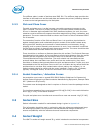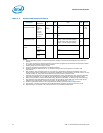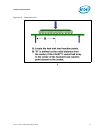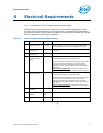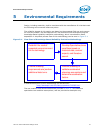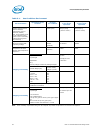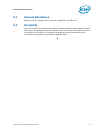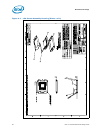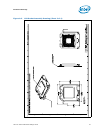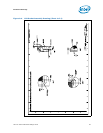
Environmental Requirements
22 LGA 771 Socket Mechanical Design Guide
Note: These reliability requirements are given as examples only based on speculative use condition assumptions.
Table 5-1. Use Conditions Environment
Use Environment
Speculative Stress
Condition
Example
Use condition
Example
7 Year stress
equivalent
Example
10 Year stress
equivalent
Slow small internal
gradient changes due to
external ambient
(temperature cycle or
externally heated)
Fast, large gradient on/off
to max operating temp.
(power cycle or internally
heated including power
save features)
Temperature Cycle ΔT = 35 - 44°C
(solder joint)
550-930 cycles
Temp Cycle Q
(-25°C to 100°C)
780-1345 cycles
Temp Cycle Q
(-25°C to 100°C)
High ambient moisture
during low-power state
(operating voltage)
THB/HAST T = 25 –30°C
85%RH
(ambient)
110-220 hrs at 110
°C 85%RH
145-240 hrs at 110°C
85%RH
High Operating
temperature and short
duration high temperature
exposures
Bake T = 95 - 105°C
(contact)
700 – 2500 hrs at
125°C
800 – 3300 hrs at
125°C
Shipping and Handling
Mechanical Shock
System-level
Unpackaged
Trapezoidal
25 g
velocity change is based on packaged weight
Total of 12 drops per
system:
2 drops per axis
± direction
n/a
Product Weight (lbs)
Non-palletized
Product Velocity
Change* (in/sec)
< 20 lbs
20 to > 40
40 to > 80
80 to < 100
100 to < 120
120
250
225
205
175
145
125
* Change in velocity is based upon a 0.5
coefficient of restitution.
Shipping and Handling
Random Vibration
System-level
Unpackaged
5 Hz to 500 Hz
2.20 g RMS random
5 Hz @ .001 g
2
/Hz to 20 Hz @ 0.01 g
2
/Hz (slope
up)
20 Hz to 500 Hz @ 0.01 g
2
/Hz (flat)
Random control limit tolerance is ± 3 dB
Total per system:
10 minutes per axis
3 axes
n/a



